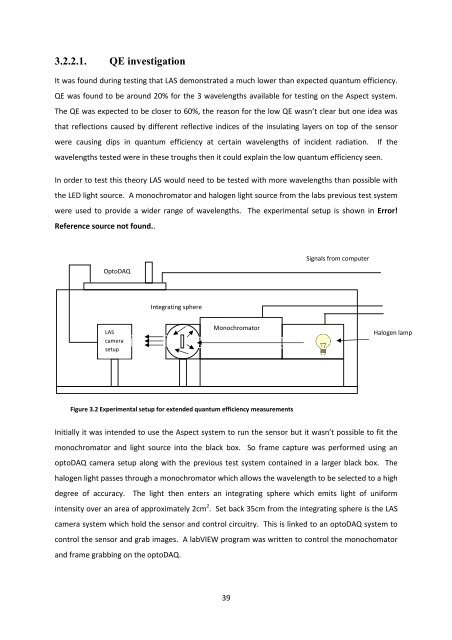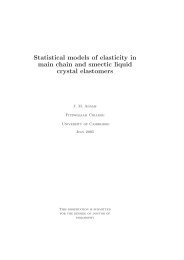Dissertation - FTP Directory Listing - University of Surrey
Dissertation - FTP Directory Listing - University of Surrey
Dissertation - FTP Directory Listing - University of Surrey
You also want an ePaper? Increase the reach of your titles
YUMPU automatically turns print PDFs into web optimized ePapers that Google loves.
3.2.2.1. QE investigationIt was found during testing that LAS demonstrated a much lower than expected quantum efficiency.QE was found to be around 20% for the 3 wavelengths available for testing on the Aspect system.The QE was expected to be closer to 60%, the reason for the low QE wasn’t clear but one idea wasthat reflections caused by different reflective indices <strong>of</strong> the insulating layers on top <strong>of</strong> the sensorwere causing dips in quantum efficiency at certain wavelengths <strong>of</strong> incident radiation. If thewavelengths tested were in these troughs then it could explain the low quantum efficiency seen.In order to test this theory LAS would need to be tested with more wavelengths than possible withthe LED light source. A monochromator and halogen light source from the labs previous test systemwere used to provide a wider range <strong>of</strong> wavelengths. The experimental setup is shown in Error!Reference source not found..OptoDAQSignals from computerIntegrating sphereLAScamerasetupMonochromatorHalogen lampFigure 3.2 Experimental setup for extended quantum efficiency measurementsInitially it was intended to use the Aspect system to run the sensor but it wasn’t possible to fit themonochromator and light source into the black box. So frame capture was performed using anoptoDAQ camera setup along with the previous test system contained in a larger black box. Thehalogen light passes through a monochromator which allows the wavelength to be selected to a highdegree <strong>of</strong> accuracy. The light then enters an integrating sphere which emits light <strong>of</strong> uniformintensity over an area <strong>of</strong> approximately 2cm 2 . Set back 35cm from the integrating sphere is the LAScamera system which hold the sensor and control circuitry. This is linked to an optoDAQ system tocontrol the sensor and grab images. A labVIEW program was written to control the monochomatorand frame grabbing on the optoDAQ.39
















